How to Drive Better Employee Engagement
Find out about the philosophy of continuous engagement, as well as our best practices for running engagement initatives within your organization.
Watch the full webcast here:
Embedded content: https://www.youtube.com/embed/40Orm61wwBs
Download the slide deck here
What is Engagement?
Employee engagement is more than sending out a survey one per year. It is a carefully established workplace culture that is nurtured over time, with well-defined employee initiatives tied to a corporate vision. Engaged employees are fully involved in and passionate about their organization, and therefore act in a way that furthers the organization's success.
True employee engagement means creating a unique experience for each and every employee based on their personal motivators and providing recognitions for their efforts and achievements. It is a practice of regularly communicating high-level goals to employees, with full transparency around changing expectations and priorities.
Only 1/3 of employees are actively engaged with their organization
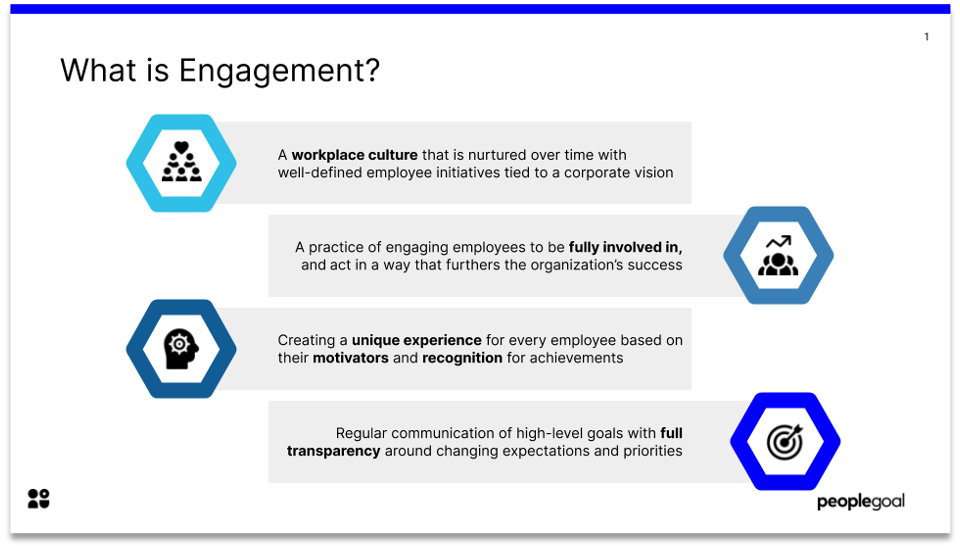
The Philosophy of Continuous Engagement
Effective employee engagement goes beyond team-building exercises and company outings, it's about creating a deeper and more meaningful connection between employees and their organization. This can be achieved through practicing the fundamental principles of continuous employee engagement:
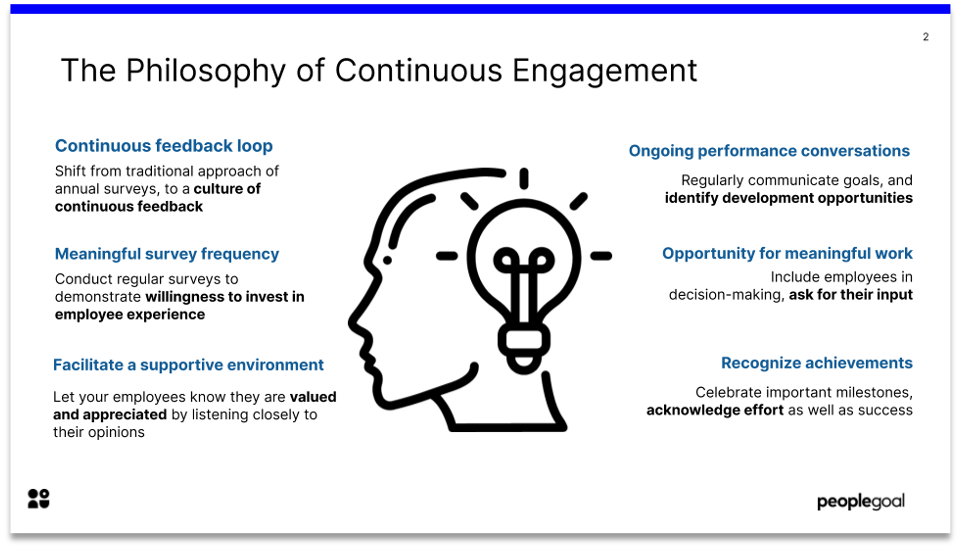
- Establish a continuous feedback loop
- Conduct engagement surveys with a meaningful frequency
- Facilitate a supportive environment
- Have ongoing performance conversations
- Provide an opportunity for meaningful work
- Recognize employee effort and achievements
Benefits of Continuous Engagement
Employees that are continuously engaged are more motivated, satisfied and dedicated to the organization. They are also much happier and healthier than disengaged employees. According to Gallup, highly engaged teams are 21% more productive than those with low engagement. High productivity rates lead to boosted overall company performance, are are linked to high employee retention rates.
Continuously engaging employees helps to build a united organization, as it sends a clear message that management cares about each and every employee. It also facilitates open communication and transparency throughout the organization, trouble shooting small issues before they escalate into bigger problems.

Tools for Enagement
There is a broad range of options with which to measure engagement other than the outdated annual engagement survey. We recommend that you test a few of the options suggested below to find out what suits your company culture, and what your and employees and managers have time to do.
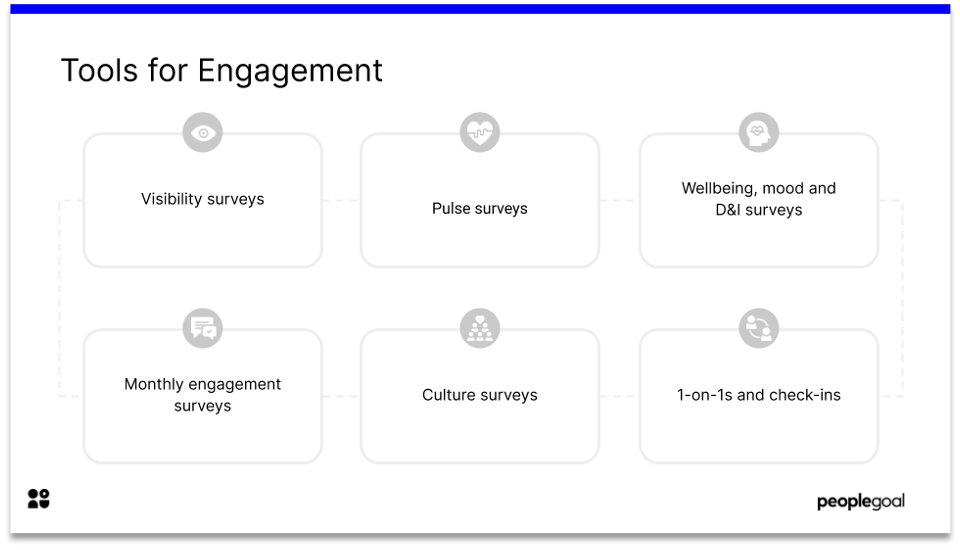
Visibility surveys gives an opportunity for leadership to gather vital insights into the overall picture of engagement with the organization. In practice, you run a poll to capture trending employee matters and the most voted questions are addressed by the leadership team in a Q&A all-hands session.
Pulse surveys give the organization the freedom to measure engagement on a regular basis. You will be able to track the same item over time, for example Employee Net Promoter Score (eNPS). Pulse surveys are shorter than annual engagement surveys, far easier to complete and more frequent.
Running wellbeing, mood and D&I surveys will show genuine interest around employee mental and physical state, as well as commitment to providing equal opportunities. Embracing wellbeing and D&I surveys will identify other areas that require the companies attention, or else they might inhibit performance and productivity.
Recurring monthly engagement surveys provide an insight into how happy employees are at work. It is good practice to use light-weight questions that allow employees to complete the survey in seconds, and then analyse sentiment trends over time after feedback is provided.
Culture surveys allow you to gain insights from employees that are associated with an organization's culture initiatives, enhancing leadership strategies, future investments and overall changes within the organization.
Finally, whilst 1-on-1s and check-ins usually fall under the umbrella of performance, you can leverage these sessions to identify levels of engagement. To achieve this, you must train managers to create questions that diagnose employees' emotional attachment to the company. By gathering data this way, you will get a snapshot of employee engagement that is related to performance and development issues.
Metrics for Engagement
Striking a balance between quantitative and qualitative metrics will allow you to gather a holistic representation of employee engagement within your organization.
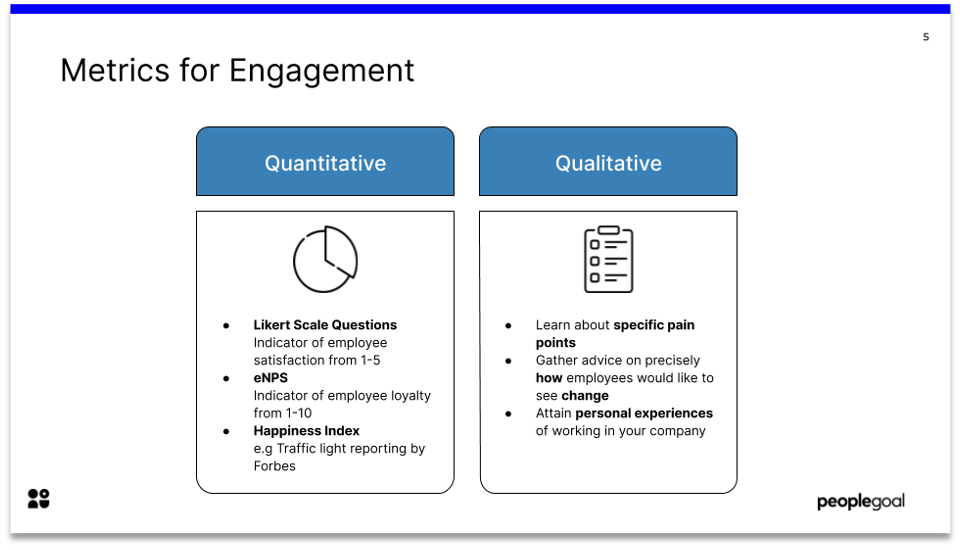
Quantitative
Likert Scale Questions
"Overall, how satisfied are you with our company?" (Very satisfied, somewhat satisfied, Neither satisfied nor dissatisfied, Somewhat dissatisfied, Very dissatisfied)
Employee Net Promoter Score (eNPS)
"On a scale of 1-10, how likely are you to recommend this company as a good place to work". 0-6 are detractors, 7-8 are passive, 9-10 are promoters
Happiness Index
Employees indicate their mood using a traffic light system (red, amber, green)
Qualitative
Gather thoughts and feedback from employees about their personal experiences of working in your company. Learn about specific pain points by gathering written feedback from employees about precisely how they would like to see change.
Practical Implications: Frequency

- Establish a baseline with a more comprehensive survey, and then set up pulse surveys to monitor progress.
- Send out surveys regularly.
- Ensure you have the appropriate resources to process the data that you gather.
- Be mindful of survey fatigue, don't overwhelm your employees with too many surveys.
- Plan for slow periods where your employees have time to complete the survey.
- Use technology to automate your surveys so you can dedicate more time to making the appropriate changes.
Practical Implications: Topic
It is important to ask questions that are relevant to a specific point in time for your organization. For example, the questions you might ask at the beginning of Q1 will be different to those you ask at end end of Q4. Next, ensure you confirm which area you want to diagnose before sending out the survey so that you can analyse areas that matter. This could be anything from organizational resilience, to wellbeing or diversity and inclusion. It is also importance to benchmark your data internally against historic data, so you can see how results track over time, and if there are any improvements thanks to your initiatives.
Finally, to find out what works best for your organization, experiment with different types of surveys. Start small, with a simple eNPS to get your employees used to giving their feedback in this way. It is advisable to start with anonymous surveys to gain the most honest feedback from employees, however once your teams are accustomed to giving regular feedback, it could be interesting to run some transparent surveys so that you can find out which areas of your organization feel which way, perhaps some are more engaged than others.
Treat employees like customers. You need to put the same effort into planning engagement surveys for your employees as you would for your paying customers.
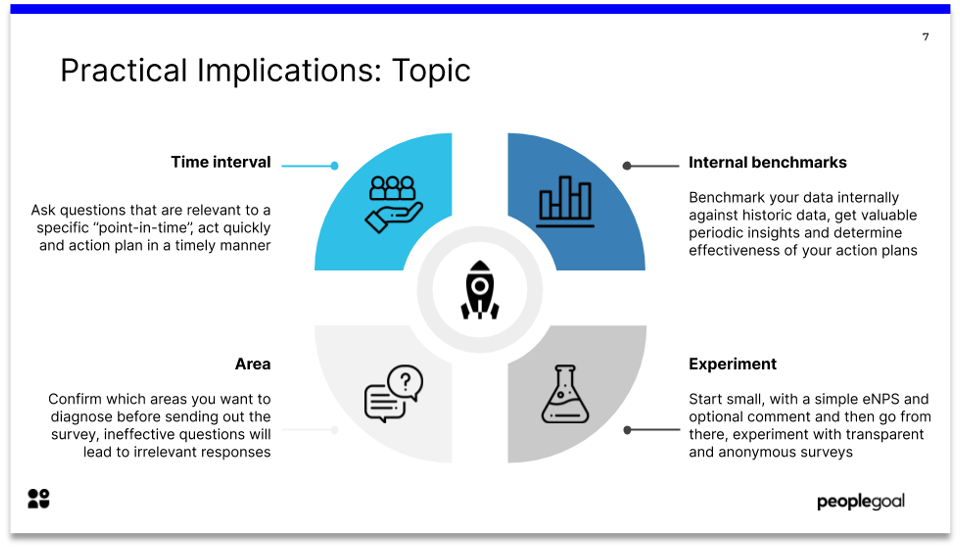
Practical Implications: Data Analysis & Taking Action
There is no value of running engagement surveys without taking action on the results. The idea is to collect data that you can use to reach conclusions that will help create a better and more engaged workforce. A survey cannot create engagement, it is a means with which to measure it. You can only create engagement by taking action.
Decide in advance who is accountable for implementing changes driven by the results, and dedicate an allotted team to process the responses and decide on actions. We recommend establishing a cross-organizational team consisting of employees and a senior leader. Finally, consider how you will communicate the results to the wider organization.
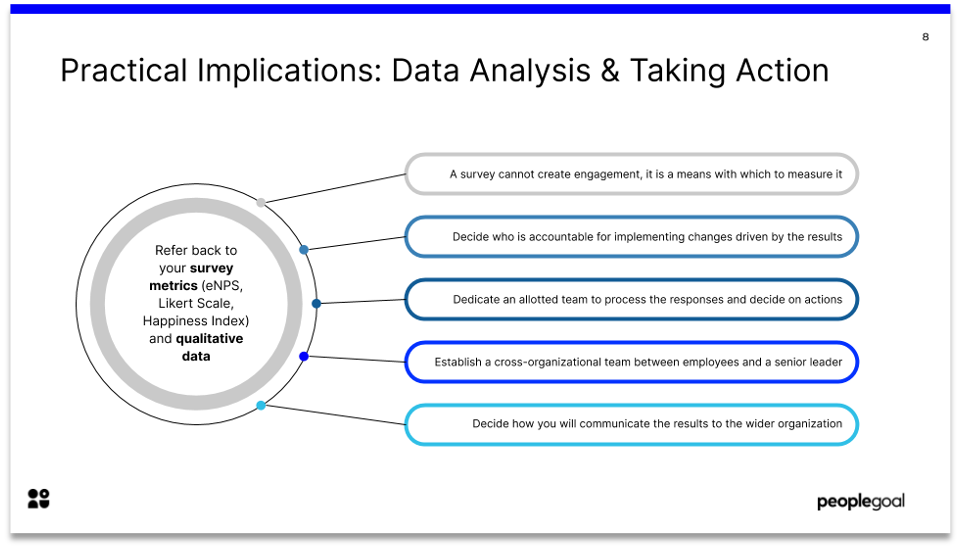
Key Takeaways
Practice continuous employee engagement
Run a regular cadence of employee surveys, without creating survey fatigue
Utilize a combination of qualitative and quantitative approaches
Automate your survey cycles using engagement software
Most important of all, analyse your data and implement action-plans based on your survey results
Want to learn more?
Enjoyed learning about continuous employee engagement? Check out the full webcast here.
Catch up with our previous webcasts below:
Need some help kicking off your continuous engagement process? Check out How To Run an Employee Engagement Survey with PeopleGoal or book a demo.